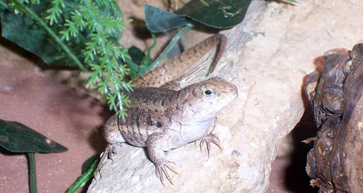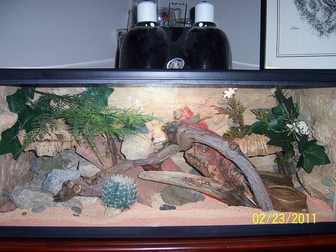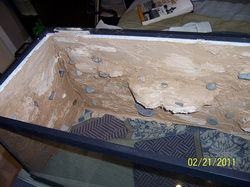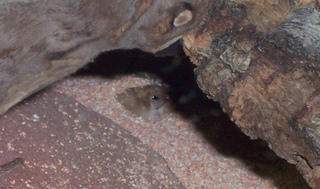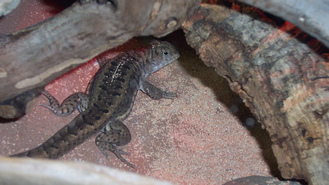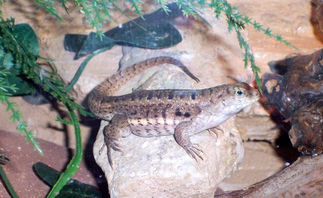Life has changed for us and my time and effort is being used to build We Heal the World.
HAITIAN CURLY TAIL LIZARD CARE
Hoyle00cdn
www.reptileforums.net
Haitian Curly Tail (Red Sided Curly Tail) Leiocephalus schreibersii
Haitian Curly Tail Care sheet As many of you already know I am the owner of two Haitian Curly Tailed lizards. This thread started out as just a simple explanation of my attempts to cohabit a juvenile male with an adult female, it turned into a full care sheet. The primary reason is because the internet seems to lack a very accurate care sheet for these wonderful animals. I don't claim to be an expert at them, but here is the information I've collected and observed so far.
The Basics
Haitian Curly Tailed lizards are a diurnal lizard and apparently not very well studied in the reptile trade. The most important thing to understand from the start is that this particular species is often easily mislabeled or misrepresented in pet stores and the internet. If you've owned one of these wonderful lizards before there's always the likely possibility it wasn't really a Haitian Curly Tail (HCT). I rarely site wikipedia as a source but to get a quick understanding of how many curly tailed species exist here's a basic reference list.
http://en.wikipedia.org/wiki/Curly-tailed_lizards
Out of this entire list the only species that is pertinent to our attention is the Red-sided Curly-tailed Lizard, Leiocephalus schreibersii. This particular lizard originated in Haiti and the Western Dominican Republic, but more recent populations have been sited in Southern Florida, Cuba and other Caribbean islands. Whether these new locations are legitimate I do not know, but it does give rise to possible reasons for the mislabeling.
To get an idea, here are some pictures of a Haitian Curly Tail and its often mistaken sister species.
Haitian Curly Tail (Red Sided Curly Tail) Leiocephalus schreibersii
http://1.bp.blogspot.com/_uHIg2bjUq4...w/s400/024.JPG
Jeweled Curly Tail (Hispaniolan Masked Curly-tailed Lizard) Leiocephalus personatus
http://www.reptilebuzz.com/images/Ha...ail_Lizard.jpg
Northern Curly Tail (Cuban Curly Tail) Leiocephalus carinatus
http://www.reptilebuzz.com/images/ba...ail-lizard.jpg
http://www.globaltwitcher.com/photo/030206.JPG
San Salvador Curly Tail Leiocephalus loxogrammus
http://www.williamkhayes.com/SaveSan...%20Burgess.jpg
Haitian Striped Curly Tail Leiocephalus pratensis
No pic available
Haitian Curly Tail Care sheet As many of you already know I am the owner of two Haitian Curly Tailed lizards. This thread started out as just a simple explanation of my attempts to cohabit a juvenile male with an adult female, it turned into a full care sheet. The primary reason is because the internet seems to lack a very accurate care sheet for these wonderful animals. I don't claim to be an expert at them, but here is the information I've collected and observed so far.
The Basics
Haitian Curly Tailed lizards are a diurnal lizard and apparently not very well studied in the reptile trade. The most important thing to understand from the start is that this particular species is often easily mislabeled or misrepresented in pet stores and the internet. If you've owned one of these wonderful lizards before there's always the likely possibility it wasn't really a Haitian Curly Tail (HCT). I rarely site wikipedia as a source but to get a quick understanding of how many curly tailed species exist here's a basic reference list.
http://en.wikipedia.org/wiki/Curly-tailed_lizards
Out of this entire list the only species that is pertinent to our attention is the Red-sided Curly-tailed Lizard, Leiocephalus schreibersii. This particular lizard originated in Haiti and the Western Dominican Republic, but more recent populations have been sited in Southern Florida, Cuba and other Caribbean islands. Whether these new locations are legitimate I do not know, but it does give rise to possible reasons for the mislabeling.
To get an idea, here are some pictures of a Haitian Curly Tail and its often mistaken sister species.
Haitian Curly Tail (Red Sided Curly Tail) Leiocephalus schreibersii
http://1.bp.blogspot.com/_uHIg2bjUq4...w/s400/024.JPG
Jeweled Curly Tail (Hispaniolan Masked Curly-tailed Lizard) Leiocephalus personatus
http://www.reptilebuzz.com/images/Ha...ail_Lizard.jpg
Northern Curly Tail (Cuban Curly Tail) Leiocephalus carinatus
http://www.reptilebuzz.com/images/ba...ail-lizard.jpg
http://www.globaltwitcher.com/photo/030206.JPG
San Salvador Curly Tail Leiocephalus loxogrammus
http://www.williamkhayes.com/SaveSan...%20Burgess.jpg
Haitian Striped Curly Tail Leiocephalus pratensis
No pic available
The Setup
*Here is a picture of my final setup.
*Here is a picture of my final setup.
Habitat
Haitian Curly Tails appear to thrive in a desert vivarium. This may sound contradictory to the climate of the Caribbean Islands, but sandy beach terrains would not fair much difference. One of my main goals in any vivarium construction is limiting the upkeep costs as much as possible. Glass holds humidity well, but I find that it doesn't do as well of a job holding heat. On the inside of the tank, I glued styrofoam on the back and sides then covered them with sand-grout. The beautiful thing with this design is the styrofoam really allows for creativity in creating ledges while the grout covers up any imperfections with a more natural look.
*Here's a look before the furniture was put in
Haitian Curly Tails appear to thrive in a desert vivarium. This may sound contradictory to the climate of the Caribbean Islands, but sandy beach terrains would not fair much difference. One of my main goals in any vivarium construction is limiting the upkeep costs as much as possible. Glass holds humidity well, but I find that it doesn't do as well of a job holding heat. On the inside of the tank, I glued styrofoam on the back and sides then covered them with sand-grout. The beautiful thing with this design is the styrofoam really allows for creativity in creating ledges while the grout covers up any imperfections with a more natural look.
*Here's a look before the furniture was put in
Furniture
These accessories were relatively cheaper to come by. Good looking fake plants can be found at the dollar store and the stems can be pushed into the exposed styrofoam at the top. This allows for the plants to hang down in the tank with a natural feel. Both the smooth beach rocks and larger rocks were collected along Lake Ontario then boiled in a pot to sterilize. The cork boards, slate rock, and fake cactus were all bought at the pet store.
Substrate
I personally choose Repti-calcium sand, which has its advantages and disadvantages. The obvious disadvantage is the risk of impaction, so many owners use paper towels or reptile carpet as an alternative. However HCTs like to burrow, they prefer to bury themselves when they feel threatened or tired. I have yet to witness either of my Haitians spend the night on a branch or rock, they are normally well hidden when they sleep. Depriving them of this sense of security could cause stress or frantic behavior. I use Reptilite, which i find to be a decent compromise. Their sand is comprised of customized spherical calcium pebbles that are said to improve pass-ability through the digestive track.
Temperature
There's a lot of controversy over this, but in my experience these guys like it HOT. Ambient temperatures during the daytime can reach anywhere from 95-105F while the basking spots can ideally hit 120F. This is primarily why I suggest a 20 gallon even for just 1 HCT, that way you can provide adequate space for shade if things get too hot. Other websites suggest 80-90F and they can live in such conditions, but it's debatable whether they like it or tolerate it.
Humidity
I am still undecided on the proper humidity controls for these guys. The desert habitat would suggest humidity levels that would resemble a Bearded Dragon setup, so 40-50% humidity appears to work. Depending on the room humidity and the type of lid I find one good misting a week to be sufficient. I use a simple screen lid with a customize sheet of plexiglass used to sit on top of the screen to hold in humidity better.
Lighting
A regular UVB/UVA bulb works well with these guys. Since their enclosures are usually not that big I go with an Exo Terra regular UVB/UVA bulb
http://www.exo-terra.com/en/products...cent_bulbs.php
I tend to avoid the regular 2.0 UVB bulb because I'm not sure it provides the right amount of UV radiation. The 2.0UVB bulb appears to be a more complementary bulb to enhance the color spectrum when combined with the 5.0 (rainforest) and 10.0 (desert) UVB bulbs. Whether or not the Haitian Curly Tail prefers a more tropical or desert habitat, it would appear a necessity to provide either a 5.0 or 10.0 UVB bulb.
I was able to capture a picture of my male burrowed deep in the sand trying to sleep. I hope this helps explain why i compromise on using sand substrate.
Sexing
Males: the male HCT tend to be roughly larger than its female counterpart. Their necks are thicker and despite the top-heavy (bulldog) appearance of both genders the males have it more profound. Neither gender carry much of a crest, but the male's crest will show noticeable protrusion at the back of the head and down its back during territorial disputes (and possibly mating too). The most distinguishing feature of the male HCT is its coloring. As a male reaches sexual maturity it will start to show vertical red lines and horizontal blue lines along its side as well as a bluish hue under its chin. I've also observed yellow spots along it's back during territorial dispute, but I am uncertain if this is restricted to territorial disputes or mating behavior as well.
Males: the male HCT tend to be roughly larger than its female counterpart. Their necks are thicker and despite the top-heavy (bulldog) appearance of both genders the males have it more profound. Neither gender carry much of a crest, but the male's crest will show noticeable protrusion at the back of the head and down its back during territorial disputes (and possibly mating too). The most distinguishing feature of the male HCT is its coloring. As a male reaches sexual maturity it will start to show vertical red lines and horizontal blue lines along its side as well as a bluish hue under its chin. I've also observed yellow spots along it's back during territorial dispute, but I am uncertain if this is restricted to territorial disputes or mating behavior as well.
Females: the female HCT is slightly more slender with a smaller head and absolutely no color. Her markings will be very similar to her male counterpart, but absent any of the beautiful reds and blues. There does appear to be one uniqueness to the female HCT. The black spot behind both shoulders appears to only be on females, although I cannot confirm if this is true for all females, but I have yet to see it on any male
*I have not been successful in identifying femoral pores in either gender, but by maturity it is extremely easy to sex this lizard
*I have not been successful in identifying femoral pores in either gender, but by maturity it is extremely easy to sex this lizard
Behavior
General Behavior
For the most part Haitian Curly Tails are active lizards. They are quick and can be rather flighty at times. As the name indicates their tails can and will curl or twitch in an animate fashion (although not as elaborate like some of its sister species). Curling usually indicates a frightened or cautious lizard, while twitching tail indicates an excited lizard ready to attack its prey or defend its territory. Similar to many other lizards, a HCT will drop its tail if it feels threatened and needs to get away. Nevertheless it is one of the fortunate reptile species that can regenerate its tail back to a similar appearance, but will probably never be as animate. They also appear to have a strong dislike for water. Originally mine were housed in an enclosure with a small water section, but neither of them went near it and would turn frantic if accidentally fallen in it. They also appear to shed just fine without any soaking.
Taming
Haitian Curly Tails domesticate relatively well. They are non aggressive, and don't appear to show the "nose-bouncing" tendencies observed in other reptiles. However there is a catch; these lizards do no care much for handling at all. Getting them out of the tank can be rather tricky, and they will run from you if they have the chance. With patience it is possible to hand feed them, but for the most part you cannot expect to bond with them the same way you would with a beardie.
Social Behavior
Where Haitian Curly Tails lack in taming, they make up for it in social behavior. Many lizards head bob as a sign of communication, but HCTs head bob like a wall of bobble-heads at a sporting goods store. I've seen mine head bob so vigorously they lose footing or shake the plant they are sitting on. For the most part it is a treat to watch, but sadly this behavior is almost non-existent when there isn't another Haitian in the enclosure. These lizards are quick to claim what's theirs and have no problem taking what's not. They're kind of like children fighting over who gets the best basking spot or who gets to eat first.
Fighting
Although they love to socialize, this doesn't mean there aren't some precautions. Unless you are housing them in a fairly large enclosure (like a 75 gallon) it's best NOT to house two males together past maturity. Their territories will constantly overlap and if there aren't enough females to satisfy the two, you'll end up with constant fighting. I've yet to come across a single example of one HCT killing another, but missing tails and fingers are a definite possibility. It's also best to avoid housing two Haitians of different sizes together especially if the older one is a female. These lizards LOVE to put each other in their place if they have the chance, so putting a juvenile with an adult is just asking for trouble.
Diet
These lizards are hungry eaters and will eat just about anything, so long as it's an invertebrate. i've read that they will eat some fruit and vegetables, but I've had no such luck yet. As for insects, I've had success with crickets, mealworms, waxworms, silkworms, baby roaches, and honey-worms. Although I advise against honey-worms, they don't seem to digest them well and just pass them whole. Water should be provided in a dish and cleaned daily.
Supplements
HCTs need calcium supplements with D3 like most diurnal lizards, but the wonderful thing about Haitians is their eager appetite. If your Haitian takes a liking to silkworms, this can help reduce the amount of calcium (D3) dusting you have to do, since silkworms are naturally high in calcium and too much D3 can actually be harmful to your lizard.
General Behavior
For the most part Haitian Curly Tails are active lizards. They are quick and can be rather flighty at times. As the name indicates their tails can and will curl or twitch in an animate fashion (although not as elaborate like some of its sister species). Curling usually indicates a frightened or cautious lizard, while twitching tail indicates an excited lizard ready to attack its prey or defend its territory. Similar to many other lizards, a HCT will drop its tail if it feels threatened and needs to get away. Nevertheless it is one of the fortunate reptile species that can regenerate its tail back to a similar appearance, but will probably never be as animate. They also appear to have a strong dislike for water. Originally mine were housed in an enclosure with a small water section, but neither of them went near it and would turn frantic if accidentally fallen in it. They also appear to shed just fine without any soaking.
Taming
Haitian Curly Tails domesticate relatively well. They are non aggressive, and don't appear to show the "nose-bouncing" tendencies observed in other reptiles. However there is a catch; these lizards do no care much for handling at all. Getting them out of the tank can be rather tricky, and they will run from you if they have the chance. With patience it is possible to hand feed them, but for the most part you cannot expect to bond with them the same way you would with a beardie.
Social Behavior
Where Haitian Curly Tails lack in taming, they make up for it in social behavior. Many lizards head bob as a sign of communication, but HCTs head bob like a wall of bobble-heads at a sporting goods store. I've seen mine head bob so vigorously they lose footing or shake the plant they are sitting on. For the most part it is a treat to watch, but sadly this behavior is almost non-existent when there isn't another Haitian in the enclosure. These lizards are quick to claim what's theirs and have no problem taking what's not. They're kind of like children fighting over who gets the best basking spot or who gets to eat first.
Fighting
Although they love to socialize, this doesn't mean there aren't some precautions. Unless you are housing them in a fairly large enclosure (like a 75 gallon) it's best NOT to house two males together past maturity. Their territories will constantly overlap and if there aren't enough females to satisfy the two, you'll end up with constant fighting. I've yet to come across a single example of one HCT killing another, but missing tails and fingers are a definite possibility. It's also best to avoid housing two Haitians of different sizes together especially if the older one is a female. These lizards LOVE to put each other in their place if they have the chance, so putting a juvenile with an adult is just asking for trouble.
Diet
These lizards are hungry eaters and will eat just about anything, so long as it's an invertebrate. i've read that they will eat some fruit and vegetables, but I've had no such luck yet. As for insects, I've had success with crickets, mealworms, waxworms, silkworms, baby roaches, and honey-worms. Although I advise against honey-worms, they don't seem to digest them well and just pass them whole. Water should be provided in a dish and cleaned daily.
Supplements
HCTs need calcium supplements with D3 like most diurnal lizards, but the wonderful thing about Haitians is their eager appetite. If your Haitian takes a liking to silkworms, this can help reduce the amount of calcium (D3) dusting you have to do, since silkworms are naturally high in calcium and too much D3 can actually be harmful to your lizard.
Introduction of Male and Female
When I first got my two HCTs they were both juveniles and their sex could not be determined yet. After a couple sheds color began to show in both of my juveniles indicating two males. It didn't take long before the two started bickering over territory, so I decided to trade one in for a female before any serious injury could take place. To avoid a similar result I opted for an adult female, but found the decision to be problematic when I tried to introduce her to my juvenile male. Territorial disputes continued but this time the size difference put my adult female at a big advantage and it didn't take long before my male was the victim of bullying. After he had lost a 1/4 inch of his tail I decided to separate them until a later date.
Once separated I began feeding my male a heavier diet in an attempt to bulk him up. After a couple weeks he appeared closer to her size, so I reintroduced them, but the results were the same as before. It's imperative to monitor any cohabitation attempts to separate immediately if need be. It doesn't take very long for two Haitian Curly Tails to have a stand off. Both will puff their chins and males will especially puff their crests. Head bobbing will ensue and if neither one lowers their head to the ground they will circle each other and begin to head butt in an attempt to bite the crest of the other. For the most part their threats appear harmless, but if one or the other is too afraid to defend itself at all its best to separate; otherwise the dominant one will claim the entire tank.
Recently I tried reintroducing them again and this was what happened...
http://www.flickr.com/photos/58798491@N06/5556221395/
What you see in this video is the first time my male has ever stood off against my female. In the past the territorial dispute was relatively short, my male's crest would disappear and she would begin chasing him around the tank trying to bite his tail. My male would then hide in a corner until the female was removed. Today's results were much different. My male did not run, and did not stand down. The video is short but the confrontation ended shortly after and instead of hiding my male stayed in plain view basking for the rest of the day.
Update on Introduction: Eventually I decided to separate the two again. The male stopped standing his ground against the female's challenges and reverted back to his submissive self. Although the end result was not a successful cohabitation, there has been progress. The larger my male gets the more confidence he appears to be gaining. The degree of aggression from the female is not nearly as intense, but for the sake of maintaining the male's confidence I will continue with temporary cohabitation attempts monitoring the progress.
Introduction update: Currently my Haitian curly tails are living together once more. The female appears to still be the dominant one, but there are noticeably less quarrels. For the time being they appear to take turns coming out to bask and eat. It's still far too early to suggest they enjoy each others company, but they appear to have a better understanding of where each others territory is now.
When I first got my two HCTs they were both juveniles and their sex could not be determined yet. After a couple sheds color began to show in both of my juveniles indicating two males. It didn't take long before the two started bickering over territory, so I decided to trade one in for a female before any serious injury could take place. To avoid a similar result I opted for an adult female, but found the decision to be problematic when I tried to introduce her to my juvenile male. Territorial disputes continued but this time the size difference put my adult female at a big advantage and it didn't take long before my male was the victim of bullying. After he had lost a 1/4 inch of his tail I decided to separate them until a later date.
Once separated I began feeding my male a heavier diet in an attempt to bulk him up. After a couple weeks he appeared closer to her size, so I reintroduced them, but the results were the same as before. It's imperative to monitor any cohabitation attempts to separate immediately if need be. It doesn't take very long for two Haitian Curly Tails to have a stand off. Both will puff their chins and males will especially puff their crests. Head bobbing will ensue and if neither one lowers their head to the ground they will circle each other and begin to head butt in an attempt to bite the crest of the other. For the most part their threats appear harmless, but if one or the other is too afraid to defend itself at all its best to separate; otherwise the dominant one will claim the entire tank.
Recently I tried reintroducing them again and this was what happened...
http://www.flickr.com/photos/58798491@N06/5556221395/
What you see in this video is the first time my male has ever stood off against my female. In the past the territorial dispute was relatively short, my male's crest would disappear and she would begin chasing him around the tank trying to bite his tail. My male would then hide in a corner until the female was removed. Today's results were much different. My male did not run, and did not stand down. The video is short but the confrontation ended shortly after and instead of hiding my male stayed in plain view basking for the rest of the day.
Update on Introduction: Eventually I decided to separate the two again. The male stopped standing his ground against the female's challenges and reverted back to his submissive self. Although the end result was not a successful cohabitation, there has been progress. The larger my male gets the more confidence he appears to be gaining. The degree of aggression from the female is not nearly as intense, but for the sake of maintaining the male's confidence I will continue with temporary cohabitation attempts monitoring the progress.
Introduction update: Currently my Haitian curly tails are living together once more. The female appears to still be the dominant one, but there are noticeably less quarrels. For the time being they appear to take turns coming out to bask and eat. It's still far too early to suggest they enjoy each others company, but they appear to have a better understanding of where each others territory is now.
